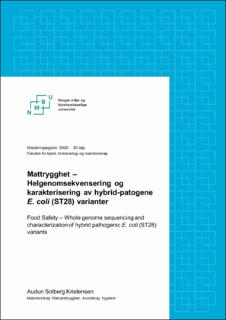| dc.contributor.advisor | Lindstedt, Bjørn-Arne | |
| dc.contributor.author | Kristensen, Audun Solberg | |
| dc.date.accessioned | 2020-09-30T10:57:45Z | |
| dc.date.available | 2020-09-30T10:57:45Z | |
| dc.date.issued | 2020 | |
| dc.identifier.uri | https://hdl.handle.net/11250/2680492 | |
| dc.description.abstract | Bakgrunn: Escherichia coli (E. coli) er en vanlig tarmbakterie som kan isoleres både fra menensker og dyr. Denne bakterien har et plastisk genom, som er årsaken til at vi i dag finner mange genetiske ulike stammer, både patogene og apatogene. Patogen E. coli kan forårsake både intestinal (IPEC) og ekstraintestinal (ExPEC) sykdom. Den kontinuerlige evolusjonen av patogen E. coli er en utfordring for klassifisering av bakterien i ulike patogrupper. Nye patogene hybride stammer med virulensfaktorer tilhørende både IPEC og ExPEC oppdages stadig, og det er viktig å karakterisere og følge med på utviklingen av disse stammene da de kan utgjøre en global trussel.
Hensikt: I denne masteroppgaven hadde vi til hensikt å karakterisere og undersøke forskjellige patogene E. coli (ST28) stammer på genomnivå, som har forårsaket intestinal sykdom i lang tid i Norge.
Metode: Helgenomsekvenser av 7 ulike ST28 stammer isolert fra pasienter med diarè (6 isolert fra Norge og en fra Italia) ble analysert og sammenliknet ved bruk av forskjellige bioinformatiske verktøy med hensikt å karakterisere og undersøke forskjellige virulensassosierte gener (VAGs).
Resultater: Alle stammene som ble undersøkt hadde både VAGs assosiert med IPEC og ExPEC. Forskjellige stammer hadde også kombinasjoner av VAGs assosiert med patotypene Enteropatogen Escherichia coli (EPEC), Enterotoksisk Escherichia coli (ETEC), Meningitt-assosiert Escherichia coli (MNEC) og Uropatogen Escherichia coli (UPEC). Stammen M884Italy hadde samme EPEC assosierte VAGs som de fleste stammene, men det ble også indentifisert shigatoksin type 2 (stx2), som er spesifikt assosiert med Enterohemoragisk Escherichia coli (EHEC).
Konklusjon: Funnene viser at kombinasjoner av VAGs assosiert med IPEC og ExPEC finnes i ST28 stammer isolert fra norske pasienter med diarè. Dette kan utgjøre en trussel for den norske befolkningen, særlig for VAGs som kan bidra til å forårsake systemisk i utsatte pasientgrupper. Den høye forekomsten av høyst prediktive UPEC VAGs hos flere av stammene er bekymringsfullt, særlig med hensyn til hvor vanlig denne typen infeksjon er både globalt og nasjonalt i Norge. | en_US |
| dc.description.abstract | Background: Escherichia coli (E. coli) is a common intestinal bacterium found in both animals and humans. This bacterium has a plastic genome, which is the reason we today find many genetically different strains, both pathogenic and apathogenic. Pathogenic E. coli is able to cause both intestinal (IPEC) and extraintestinal (ExPEC) disease. The continuous evolution of pathogenic E. coli is a challenge to the classification of this bacteria into different pathogroups. With novel pathogenic hybrid strains emerging, harboring possible virulence factors associated with both IPEC and ExPEC, it is important that these strains are monitored and characterized as they may become a global threat.
Purpose: In this master thesis, we wanted to characterize and investigate on the genomic level different pathogenic E. coli (ST28) strains which have caused intestinal disease in Norway for a long period of time.
Methods: Whole genome sequences of 7 different ST28 strains isolated from patients with diarrhea (6 isolated from Norway and 1 from Italy) were analyzed and compared using different bioinformatic tools with the aim of characterization and investigation of different virulence associated genes (VAGs).
Results: All the strains investigated were shown to have VAGs associated with both IPEC and ExpEC. Different strains also had combinations of VAGs associated with the pathotypes Enteropathogenic Escherichia coli (EPEC), Enterotoxic Eschierchia coli (ETEC), Meningitis associated Escherichia coli (MNEC) and Uropathogenic Escherichia coli (UPEC). The strain M884Italy had the same EPEC associated VAGs as most of the other strains, but also harbored the shigatoxin type 2 (stx2) gene specifically associated with Enterohemorrhagic Escherichia coli (EHEC).
Conclusion: The findings show that combinations of VAGs associated with ExPEC and IPEC are found in ST28 strains isolated from Norwegian patients with diarrhea. This could be a potential threat for the Norwegian population, especially because of VAGs that could contribute to systemic infections in susceptible patients. The common occurrence of highly predictive VAGs of the UPEC pathotype among the strains is alarming, considering how common this type of infection is both globally and nationally in Norway. | en_US |
| dc.language.iso | nob | en_US |
| dc.publisher | Norwegian University of Life Sciences, Ås | en_US |
| dc.rights | Navngivelse 4.0 Internasjonal | * |
| dc.rights.uri | http://creativecommons.org/licenses/by/4.0/deed.no | * |
| dc.subject | Hybrider | en_US |
| dc.subject | EPEC | en_US |
| dc.subject | UPEC | en_US |
| dc.subject | IPEC | en_US |
| dc.subject | ExPEC | en_US |
| dc.subject | Hyrbid-assembly | en_US |
| dc.subject | Virulensfaktorer | en_US |
| dc.subject | NGS | en_US |
| dc.subject | Nanoporesekvensering | en_US |
| dc.subject | FHI | en_US |
| dc.subject | MinION | en_US |
| dc.title | Mattrygghet : helgenomsekvensering og karakterisering av hybrid-patogene E. coli (ST28) varianter | en_US |
| dc.title.alternative | Food safety : whole genome sequencing and characterization of hybrid pathogenic E. coli (ST28) variants | en_US |
| dc.type | Master thesis | en_US |
| dc.subject.nsi | VDP::Teknologi: 500::Næringsmiddelteknologi: 600 | en_US |
| dc.source.pagenumber | 65 | en_US |
| dc.description.localcode | M-MAT | en_US |

